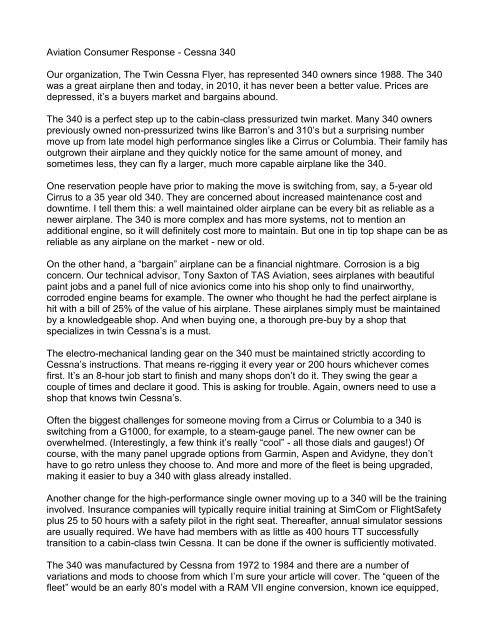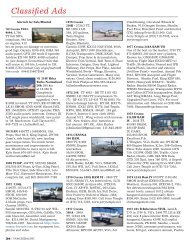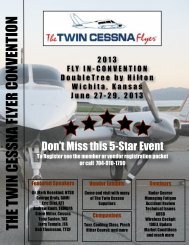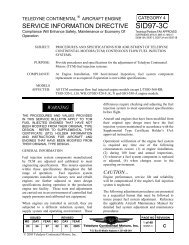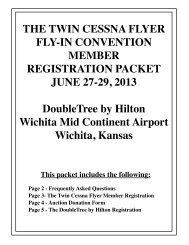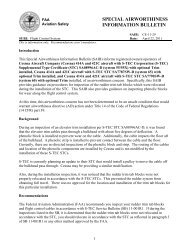340 Information - Twin Cessna Flyer
340 Information - Twin Cessna Flyer
340 Information - Twin Cessna Flyer
You also want an ePaper? Increase the reach of your titles
YUMPU automatically turns print PDFs into web optimized ePapers that Google loves.
Aviation Consumer Response - <strong>Cessna</strong> <strong>340</strong><br />
Our organization, The <strong>Twin</strong> <strong>Cessna</strong> <strong>Flyer</strong>, has represented <strong>340</strong> owners since 1988. The <strong>340</strong><br />
was a great airplane then and today, in 2010, it has never been a better value. Prices are<br />
depressed, it’s a buyers market and bargains abound.<br />
The <strong>340</strong> is a perfect step up to the cabin-class pressurized twin market. Many <strong>340</strong> owners<br />
previously owned non-pressurized twins like Barron’s and 310’s but a surprising number<br />
move up from late model high performance singles like a Cirrus or Columbia. Their family has<br />
outgrown their airplane and they quickly notice for the same amount of money, and<br />
sometimes less, they can fly a larger, much more capable airplane like the <strong>340</strong>.<br />
One reservation people have prior to making the move is switching from, say, a 5-year old<br />
Cirrus to a 35 year old <strong>340</strong>. They are concerned about increased maintenance cost and<br />
downtime. I tell them this: a well maintained older airplane can be every bit as reliable as a<br />
newer airplane. The <strong>340</strong> is more complex and has more systems, not to mention an<br />
additional engine, so it will definitely cost more to maintain. But one in tip top shape can be as<br />
reliable as any airplane on the market - new or old.<br />
On the other hand, a “bargain” airplane can be a financial nightmare. Corrosion is a big<br />
concern. Our technical advisor, Tony Saxton of TAS Aviation, sees airplanes with beautiful<br />
paint jobs and a panel full of nice avionics come into his shop only to find unairworthy,<br />
corroded engine beams for example. The owner who thought he had the perfect airplane is<br />
hit with a bill of 25% of the value of his airplane. These airplanes simply must be maintained<br />
by a knowledgeable shop. And when buying one, a thorough pre-buy by a shop that<br />
specializes in twin <strong>Cessna</strong>’s is a must.<br />
The electro-mechanical landing gear on the <strong>340</strong> must be maintained strictly according to<br />
<strong>Cessna</strong>’s instructions. That means re-rigging it every year or 200 hours whichever comes<br />
first. It’s an 8-hour job start to finish and many shops don’t do it. They swing the gear a<br />
couple of times and declare it good. This is asking for trouble. Again, owners need to use a<br />
shop that knows twin <strong>Cessna</strong>’s.<br />
Often the biggest challenges for someone moving from a Cirrus or Columbia to a <strong>340</strong> is<br />
switching from a G1000, for example, to a steam-gauge panel. The new owner can be<br />
overwhelmed. (Interestingly, a few think it’s really “cool” - all those dials and gauges!) Of<br />
course, with the many panel upgrade options from Garmin, Aspen and Avidyne, they don’t<br />
have to go retro unless they choose to. And more and more of the fleet is being upgraded,<br />
making it easier to buy a <strong>340</strong> with glass already installed.<br />
Another change for the high-performance single owner moving up to a <strong>340</strong> will be the training<br />
involved. Insurance companies will typically require initial training at SimCom or FlightSafety<br />
plus 25 to 50 hours with a safety pilot in the right seat. Thereafter, annual simulator sessions<br />
are usually required. We have had members with as little as 400 hours TT successfully<br />
transition to a cabin-class twin <strong>Cessna</strong>. It can be done if the owner is sufficiently motivated.<br />
The <strong>340</strong> was manufactured by <strong>Cessna</strong> from 1972 to 1984 and there are a number of<br />
variations and mods to choose from which I’m sure your article will cover. The “queen of the<br />
fleet” would be an early 80’s model with a RAM VII engine conversion, known ice equipped,
VG’s, spoilers and, of course, as much glass in the cockpit as possible. Equally important<br />
would be a history of maintenance by a shop specializing in twin-engine <strong>Cessna</strong>’s. If such an<br />
aircraft were built today it would cost well over $1 million, yet today can be had for well less<br />
than half that amount.<br />
After moving up to a <strong>340</strong>, what we hear most often from the new owners is how much they<br />
love the pressurization. They no longer have to cajole their family to wear oxygen cannulas.<br />
They now routinely fly in the flight levels where the airplane is faster, the airspace less<br />
crowded and it’s easier to circumnavigate the weather. It’s a whole new world for them and<br />
they often like it more than they thought they would.<br />
It is very gratifying to see people buy these airplanes and bring them up to 2010 standards.<br />
We are seeing more and more glass cockpit retrofits, complete interior renovations and, of<br />
course, new paint schemes. The result for someone making this move up is the ability to<br />
have a small, personal “airliner” that allows them to fly 4 or 5 people at 200+ knots for 3.5 to 4<br />
hours in pressurized and air conditioned comfort. Our members report all-in operating costs<br />
in the $500 to $600 per hour range.<br />
The two long term concerns for <strong>340</strong> owners are <strong>Cessna</strong>’s Supplemental Inspection<br />
Document program (SID’s) and fuel availability, given the likely phase out of 100 LL. SID’s, of<br />
course, are the industry’s way of addressing the aging GA aircraft fleet. It’s likely SID’s will be<br />
developed for all legacy GA aircraft, not just twin <strong>Cessna</strong>’s. Currently, SID’s are not<br />
mandatory in the U.S. for piston powered aircraft which, of course, includes <strong>340</strong>’s. No one<br />
has a crystal ball, but the conventional wisdom is that the FAA will continue to address<br />
specific safety concerns via AD’s and not resort to the broad brush approach of mandatory<br />
SID’s. This opinion is bolstered by the fact that the reports we are getting from overseas,<br />
where some countries require SID compliance, is that not many age related issues are being<br />
found. Some corrosion here and there, the occasional manufacturing or maintenance defect<br />
but nothing common or widespread. The <strong>340</strong> fleet appears to be aging very well.<br />
Solutions are in the works for the 100LL problem. Your publication has covered this issue<br />
extensively so I won’t address it here except to say we are optimistic that over the long run a<br />
workable solution will be found.<br />
Finally, we often hear that the piston twin market is dead, squeezed by high performance<br />
singles on the low end and turboprop singles on the high end. We respectfully disagree. You<br />
will not find a single example of either that can do what a <strong>340</strong> can do for the money - fly 4 to 6<br />
people at up to 200 kts for 800 miles with the security of a second engine - all for a purchase<br />
price of less than $300,000 and in many cases, well below that. For many people, the <strong>340</strong> is<br />
the perfect airplane for their mission.<br />
Any of your readers interested in learning more about <strong>340</strong>’s are welcome to contact us at<br />
704-910-1790 or editor@twincessna.org<br />
Bob Thomason, President<br />
The <strong>Twin</strong> <strong>Cessna</strong> <strong>Flyer</strong>


